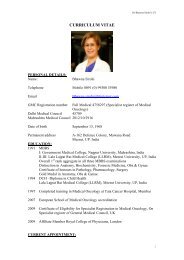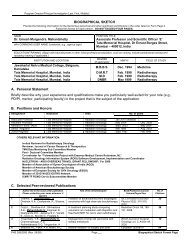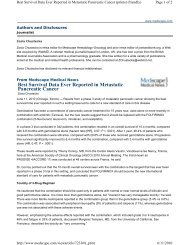Surgical Advances in Pancreatic Cancer- Beat M. Künzli
Surgical Advances in Pancreatic Cancer- Beat M. Künzli
Surgical Advances in Pancreatic Cancer- Beat M. Künzli
Create successful ePaper yourself
Turn your PDF publications into a flip-book with our unique Google optimized e-Paper software.
Introduction<br />
Despite improvements <strong>in</strong> diagnosis and therapy, pancreatic cancer is still a devastat<strong>in</strong>g<br />
disease, which is presently the fourth lead<strong>in</strong>g cause of cancer related deaths <strong>in</strong> Western<br />
countries. 1 Although significant efforts have been made, only little progress has been<br />
achieved <strong>in</strong> the last decades with respect to the overall survival of pancreatic cancer<br />
patients. It is still a challeng<strong>in</strong>g task to diagnose pancreatic cancer at an early stage that<br />
offers the chance of successful therapy. Thus, the overall resectability rate of pancreatic<br />
cancer is only 10 to 15%. 2 Rapid tumor progression, and a strik<strong>in</strong>g resistance to<br />
chemotherapy, radiotherapy, and targeted/biological therapies 3, 4 contribute to the poor<br />
prognosis. These facts together result <strong>in</strong> low tumor resectability rates after diagnosis,<br />
early tumor recurrence after resection, and poor overall survival rates. Even after<br />
potential curative resection, long term survival is not satisfactory with around 20%, but<br />
subgroup analyses of e.g. lymph node negative tumors that have been resected with<br />
negative marg<strong>in</strong>s demonstrate 5-year survival rates of about 40%. 5 In the last decade<br />
the surgical outcome has improved, mostly because of improv<strong>in</strong>g perioperative<br />
treatment. Birkmeyer et al. 6 demonstrated that operation related morbidity and mortality<br />
significantly decreases <strong>in</strong> centers with high patient load. This critical aspect of the value<br />
of centralization on the outcome of pancreatic surgery <strong>in</strong> “high volume <strong>in</strong>stitutions,” has<br />
been demonstrated <strong>in</strong> numerous studies. 7 The current mortality rate follow<strong>in</strong>g pancreatic<br />
resection is well below 5% 8 <strong>in</strong> specialized surgical centers. Improvements <strong>in</strong> multimodal<br />
therapy 9 comb<strong>in</strong>ed with more experienced surgical treatment of pancreatic cancer at<br />
high volume centers have improved the long-term survival as well as the quality of life of<br />
pancreatic cancer patients.<br />
2












